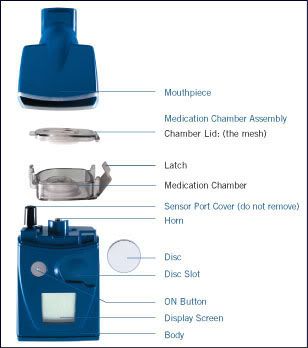By Caroline Helwick
Medscape Medical News

May 20, 2010 (New Orleans, Louisiana) — Oral iloprost, an analogue of prostacyclin, shows promise in the prevention of lung cancer in former smokers by improving endobronchial dysplasia, according to the results of a randomized phase?2 trial reported here at the American Thoracic Society 2010 International Conference.
"Iloprost improved the histology of former smokers, indicating that it may reduce the risk of developing lung cancer," said principal investigator Robert Keith, MD, from the Denver Veterans Affairs Medical Center and the University of Colorado, Denver. "Interestingly, current smokers did not show benefit."
The inhaled formulation of iloprost is currently used for the treatment of pulmonary hypertension. The oral form is no longer used in the United States, but the inhaled version was not available when this study was initiated, he noted.
Subjects were selected for the trial if they were current or former smokers (>20 pack years) and had at least mild cytologic atypia on sputum cytology and no history of cancer.
Autofluorescence and white light bronchoscopy were performed, and 6 standard endobronchial sites were biopsied, along with all other abnormally appearing areas. The histologic parameters of interest were bronchial histology, Ki-67 level, eicosanoid pathway, MCM2 protein expression, tyrosine kinase receptor protein expression, apoptotic index, and microvessel density.
The 152 subjects were randomized to 6 months of oral iloprost (in doses escalating from 50 to 150?μg twice daily) or placebo, after which they underwent a second fluorescent bronchoscopy with repeat biopsy of all the central airway areas sampled during the first bronchoscopy. The predetermined primary end point of the study was bronchial histology in all subjects, and in current and former smokers separately.
Each bronchial biopsy specimen was scored according to the World Health Organization classification for preneoplasia (scale of 1 to 8). Within-patient endobronchial histology was summarized using 3 separate measures: worst biopsy score, dysplasia index (percent of biopsies with a score of ?4, indicating mild dysplasia or worse), and average of all biopsy scores.
The average biopsy score was significantly better for former smokers than for current smokers, but there were no differences at baseline between the treatment and placebo groups in this category. Baseline demographics were also similar for the treatment groups in current smokers.
Follow-up was completed by 60 subjects in the iloprost group and 65 in the placebo group.
Favorable Histologic Changes Seen in Former Smokers
Histologic evaluation from baseline to 6 months showed that treatment with iloprost was associated with significant improvements in former smokers but not current smokers, Dr. Keith reported at the late-breaking clinical trials session.
Response to treatment was defined as a reduction of 1 point or more in maximum histology. Responses were observed in 14 of 29 (48%) former smokers receiving iloprost, compared with 4 of 28 (14%) receiving placebo. In current smokers, responses were similar between the groups (32% vs 24%, respectively).
For former smokers receiving iloprost, the average biopsy score decreased from 2.12 at baseline to 1.73 after 6 months of treatment. Scores in the placebo group were 2.07 and 2.11, respectively.
The worst biopsy score improved by 1.4 in former smokers, he added.
A significant treatment effect was seen for all measures — average biopsy score, worst biopsy score, and dysplasia index — among the former smokers receiving the drug. The most common adverse effect of the drug was headache.
"If you take this medicine and you are a former smoker, your lung damage diminishes," Dr. Keith reiterated.
He predicted that, if further trials confirm a benefit, the likely candidates for this drug are patients diagnosed with stage?1A lung cancer whose 5-year survival is 75% and those deemed at very high risk.
He noted that the incidence of lung cancer was not used as the primary end point because this requires long-term follow-up. Lung cancer could be chosen as an end point, however, if the proposed phase?3 study is conducted. "We have now got the necessary steps to push on [to a phase?3 trial]," he told the media.
Charles Powell, MD, associate professor of medicine in the Division of Pulmonary and Critical Care at Columbia University in New York City, told Medscape Pulmonary Medicine that this is an "interesting and potentially important study because it is one of the first randomized clinical trials to show a difference in the histology of the lung" after an intervention.
He also praised the study for its "rational approach," because the investigators identified a specific target, tested the approach in an animal model, and then brought it into clinical trials.
Although the results are encouraging, he cautioned that an effect on a clinical end point — reduction in lung cancer occurrence — needs to be shown before "enthusiastically grasping onto" iloprost for chemoprevention. He also noted that the population was largely male, and that the effect was observed only in former smokers; therefore, the results cannot be extrapolated to the broader population of smokers without further study.
Dr. Keith reports having personal financial relationships with Pfizer and Boehringer-Ingelheim, and a patent application for the use of oral prostacyclin analogues in the chemoprevention of cancer.
American Thoracic Society (ATS) 2010 International Conference: Abstract?9997. Presented May?18, 2010.
作者:Caroline Helwick
出處:WebMD醫學新聞
【24drs.com】May 20, 2010(紐澳良)-根據一項發表於美國胸腔醫學會2010年國際年會的第二期研究,口服Iloprost,一種前列腺環素相似物,透過改善支氣管內皮細胞異常增生,顯示有預防肺癌的潛力。
主要作者,來自丹佛退伍軍人事務醫學中心以及丹佛柯羅拉多大學的Robert Keith醫師表示,Iloprost改善過去吸菸者的病理學,代表這可能降低發生肺癌的風險。有趣的是,目前仍然吸菸者使用並無好處。
他表示,iloprost的吸入劑型目前用於治療肺高壓。美國地區已經沒有口服劑型,但是當這個研究開始時,還沒有吸入劑型。
如果受試者目前或過去吸菸(每年超過20包),且痰液病理學檢驗有輕微細胞學異常,且沒有癌症病史,則可納入研究。
接著進行自動螢光染色與白光支氣管鏡,並對6個標準支氣管內部位進行切片,還有所有其他異常表現部位。進行的組織範圍為支氣管組織學、Ki-67濃度、類花生酸途徑、MCM2蛋白表現、酪氨酸受體蛋白表現、細胞凋亡指標、以及微血管密度。
在第一次支氣管鏡時對所有中央氣管區域進行採樣,這些區域在第二次螢光支氣管鏡檢查時再次進行切片,之後152位受試者被隨機分派接受6個月的口服iloprost(劑量從50-150 μg每天兩次)或是安慰劑。研究預先決定的主要終點為所有受試者的支氣管組織學檢驗結果,依照目前或過去吸菸分開分析。
每個支氣管切片樣本根據世界衛生組織的癌前病灶分類(從1至8分)。每位病患的支氣管內切片組織以3種評量方法綜合:最差的切片分數、異常增生指標(切片樣本分數大於等於4分的百分比,代表異常增生或更糟)、以及所有切片分數的平均。
相較於目前吸菸者,過去吸菸者平均切片分數顯著較好,但是在這個分類中,試驗前治療與安慰劑組之間並無顯著差異。目前吸菸者中,治療組的試驗前流行病學資料也是相似的。
Iloprost組有60位受試者、安慰劑組有65位受試者完成後續追蹤。
【過去吸菸者的組織學檢驗變化較佳】
Keith醫師在臨床試驗最新發現座談會中報告,試驗前到6個月後,組織學檢驗結果顯示,以iloprost治療與過去吸菸者顯著改善有關,但在目前仍吸菸者則無這樣的結果。
治療反應的定義是最高組織學分數下降1分以上。過去吸菸者使用iloprost的受試者中,29位中有14位(48%)觀察到反應,安慰劑組則是28位中有4位(14%)。在目前吸菸者之間,不同組的反應是相似的(分別為32%與24%)。
接受iloprost的過去吸菸者,平均切片分數從試驗前的2.12分到治療6個月後的1.73分。安慰劑組的分數分別為2.07分與2.11分。
他附帶表示,過去吸菸者最差的切片分數為1.4分。
過去吸菸且接受iloprost的受試者,所有評量都可以看得到顯著的治療效應,包括平均切片分數、最差切片分數、以及異常增生指標。使用藥物最常見的不良反應為頭痛。
Keith醫師重申,如果你使用這個藥物,且你過去曾經吸菸,你的肺部傷害將會被降低。
他預測,如果未來的研究確認了這個好處,使用這個藥物可能的對象為診斷罹患1A期的肺癌患者,這些病患的5年存活率達75%,以及那些被認為處於高風險患者。
他表示,肺癌的發生率並未被當作這個研究的主要終點,因為這需要長期後續追蹤。然而,如果進行被建議的第三期臨床研究的話,肺癌可以被選作一個試驗終點。他告訴媒體,我們現在已經走到必須進行第三期臨床研究的階段。
紐約市哥倫比亞大學胸腔醫學與重症照護部門副教授Charles Powell醫師向Medscape胸腔醫學表示,這是個很有趣且潛在重要的研究,因為這是第一個顯示肺組織學檢驗結果在介入後可以改善的隨機分派研究。
他也稱讚這項研究「合理的做法」,因為研究者們找到了一個特定的標的,在動物模式測試這個方法,且接著將其帶入臨床研究。
雖然這些研究結果是令人感到激勵的,但他提醒,在一股腦地使用iloprost作為化學預防之前,應該先看到對臨床試驗終點的效果,也就是肺癌發生率下降。他也表示,該族群大部分為男性,且這個效果僅在過去吸菸者身上看到;因此,在沒有進一步研究之前,這項研究結果不能外推到更廣的吸菸族群。
Keith醫師表示與輝瑞藥廠以及百靈佳殷格翰有個人資金上的往來,以及擁有使用口服前列腺環素相似物用於肺癌化學預防的專利應用。


可以參考一下機轉圖:圖解藥理學-18降血壓藥物





 留言列表
留言列表
 線上藥物查詢
線上藥物查詢 